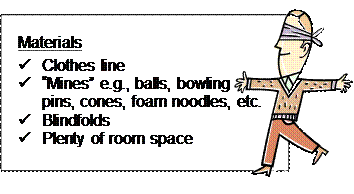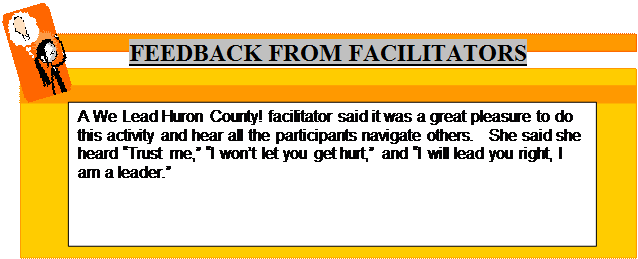
Главная страница Случайная страница
КАТЕГОРИИ:
АвтомобилиАстрономияБиологияГеографияДом и садДругие языкиДругоеИнформатикаИсторияКультураЛитератураЛогикаМатематикаМедицинаМеталлургияМеханикаОбразованиеОхрана трудаПедагогикаПолитикаПравоПсихологияРелигияРиторикаСоциологияСпортСтроительствоТехнологияТуризмФизикаФилософияФинансыХимияЧерчениеЭкологияЭкономикаЭлектроника
Non-Verbal Behavior and Feelings
|
|
Time: 60 Minutes
Purpose: Explore the connection between non-verbal behavior and feelings/emotion.
Directions: Have participants review what they learned yesterday about non-verbal communication. Inform participants that non-verbal communication is one of the primary ways people convey the feeling or emotion behind a message. Provide the following examples participants might experience in their personal lives:
- A mother increasing the volume of her voice when her child talks back to her.
- A teacher raising the tone of his voice the fourth time he asks a participant to stop engaging in a disruptive behavior.
- A friend displaying a slight frown while at the same time telling you he/she would be thrilled to go with you to the movie you just suggested.
Point out to participants that the easiest way to enhance their ability to accurately read the non-verbal communication of others is to practice.
Have participants divide into pairs or groups of three. Distribute Expressions of Emotion (handout).
- Ask each small group to identify five or six feelings/emotions. Then ask them to select three of those feelings to use in completing Expressions of Emotions (handout).
- Using those three feelings, have them brainstorm to come up with as many cues as possible that would indicate a person is experiencing each of those emotions. The cues should include verbal (words, tone of voice, volume of voice) and nonverbal (facial expression and posture).
After they complete the worksheet, ask the small groups to discuss the following:
· Which feelings or emotions do you think are easiest to recognize in others? Which are most difficult?
Have participants practice identifying feelings through observing non-verbal behavior.
Have participants remain in small groups. Distribute Practice in Non-verbal Communication (handout).
Direct participants to take turns selecting a feeling/emotion listed on the handout and then non-verbally communicate it to others in the group. Have those participants who are not communicating the emotion “read” the non-verbal cues presented to them and identify the feeling.
Allow approximately one minute for each participant to communicate a feeling non-verbally. If group members have not been able to guess the feeling within this period of time, have them verbally communicate the feeling they are attempting to express and move on to the next participant. Provide sufficient time so that each participant is given the opportunity to communicate a minimum of two different types of feelings.
Bring the group back together as a large group and discuss the exercise. Possible discussion questions include:
· How accurately and completely were people able to communicate their feelings/emotions?
· Which feelings were easiest to communicate? Why?
· Which forms of non-verbal behavior (facial expressions, gestures, tone of voice, etc) appear to be the most accurate communicators of feelings/emotions?
Point out to the participants that just as persons without disabilities use non-verbal communication, so do individuals with disabilities. In fact, for some persons with disabilities, this may be the primary way in which they communicate.
Discuss with participants the societal barriers that persons with disabilities who communicate solely in a non-verbal manner are likely to face. Make sure to include the following points in your discussion:
- Many individuals do not even pay attention to or notice the attempts of others to communicate non-verbally. It is much easier to get someone’s attention verbally.
- Many persons are not able to accurately read non-verbal communication even when they are aware it’s being used to convey a message. Others may misinterpret the message a person is attempting to send.
- Non-verbal communication may convey some parts of a message (feelings) well, but it much more difficult to use to convey the content of a message unless it is part of a formal system of communication (American Sign Language).
Point out that because of all the reasons discussed, it is extremely important to double check with the speaker as to the intent of his/her non-verbal communication as well as verbal communication.
Death in the Dessert Game [1]

Time: 45 Minutes
Source: Games Teams Play
Purpose: This is a team building activity that will enhance the participants’ ability to work together and problem solve. It will encourage them to think “outside the box.”
Directions:
Divide the participants into groups or four or five. Tell the groups you are going to give them a riddle to solve. The answer to the riddle will be given to one member of each group. The rest of the group members must discover the answer by asking questions that can only be answered with “yes” or “no.”
Take the designated group members aside and give them the answer. Explain that they do not have to remember the riddle since you will be telling the entire group. Also, remind them that it is very important they do not share the answer with the rest of their team and only respond with a “yes” or “no” to their questions.
Read this riddle to everyone in the room:
“A man was found dead in the dessert. Near him was a package. If he had opened the package, he would not have died. What was in the package? ”
Give the groups 5-10 minutes to ask questions. After time is up, see if any group guessed the answer. If not, share it with them: A parachute!
As a large group, discuss the following questions (notes to the facilitator are in italic)
- Was this difficult? If it was, what made it difficult?
- This will only give you an idea of their self-assessment. You will be able to tell for yourself if they are having difficulty. They will focus on the riddle itself, but you can pose the following questions about the process of problem solving. Keep in mind that problem solving is very important to organizing and any activity such as this will help them to develop their problem solving skills.
- Were your ideas heard? At any point, did you lose track of a really good idea, an idea that had you on the right track?
- Talk about the importance of always recognizing the valuable contributions everyone makes and making note of all correct answers. This teaches the participants skills related to researching their issue. All good organizers need to be inquisitive and resourceful.
- Do you think your group made too many assumptions (e.g. the desert caused his death) or were you successful at clarifying information?
- Discuss how you could have prevented such assumptions. For example, the group could have asked more questions and not given up so easily or the group could have examined every word of the riddle (i.e. the word “opened” is the key) for clues, etc.
- How can we take what we’ve learned about problem solving from this riddle and use it in our organizing efforts?
- We learned the importance of asking a lot of questions when researching an issue and asking our friends for help. We also learned that when reading something (i.e. a piece of legislation), it can be important to examine every word and we may need to ask someone else if, when reading it, we see something we do not understand. In other words, we might need someone to clarify things for us and “yes” or “no” answers might not work.
- How can we prevent our group from slipping into these same problems again (i.e. making assumptions, not listening, jumping from one idea to another without building, etc)?
1. We can keep track of our ideas, make note of what we have learned from the questions we have asked and listen to what other members of our group are saying instead of planning what we are going to say next, etc.
 Roots Activity
Roots Activity
Time: 60 Minutes
Source: Adapted from Play for Performance.
Purpose: To examine how disability culture and pride can be used to support and sustain our leadership.
Directions: Give each participant an index card and pen or pencil. Tell them they are to draw a tree that can be realistic or abstract. The only critical requirement is that they only have 45 seconds to draw the tree. Pause while participants complete the task. After 45 seconds, have them stop and ask them to look at their pictures and debrief using the following questions:
- How many of the participants drew roots on their tree?
- What is holding the trees up without the roots?
- How do these trees get water and nutrition?
- Why did you not draw the roots?
- Was it because you usually don’t see the roots?
- How many other things do we habitually ignore because they are not visible?
Once the debriefing is done, shift to the large picture of a tree on the wall. Ask participants what their roots are (i.e. family, spirituality, culture, history, small successes, etc.) and write/draw them as roots on the large tree.
Some questions to get them thinking include:
-
 What holds you up in your leadership?
What holds you up in your leadership? - When things get rough, what keeps you going?
- What supports your leadership?
- Where do you draw strength from in your leadership?
Finally, as a large group, discuss how it felt doing that activity. What were some of the reactions? How did it make you feel?
Mine Field

Time: 60 minutes
(Add 20 minutes for set up)
Source: Wilderdom Store
Purpose: Participants will learn to trust and work on communication skills as they guide each other through an area full of obstacles.
Directions: Before starting the activity, one facilitator must set up the “Mine Field.” Facilitator will lay a clothes line rope on the floor in a circle and distribute “mines” (your balls, bowling pins, chairs, hats, etc) in the circle. If there is space and the weather is nice this activity can be done outside.
Facilitator will establish a concentrating and caring tone with introducing this activity. Since this activity is one that deals with trust, the facilitator needs to set a serious atmosphere to develop a genuine sense of trust and safety.
First, have participants attempt to carefully cross the field by themselves. Ask participants to break into pairs. Tell them one person will be blindfolded (or keeps eyes closed) and cannot talk (optional), while their partner can see and talk but cannot enter the field or touch their partner. The challenge is for each blindfolded person to walk from one side of the field to the other, avoiding the mines, by listing to the verbal instructions of their partners. Decide on the penalty for hitting a mine. It could be a restart (serious consequence) or time penalty or simply a count of hits but without penalty.
Allow participants a short period (e.g., 3 minutes) of planning time to decide on their communication commands. It can help participants if you suggest they each develop a unique communication system. When participants swap roles, give participants some review and planning time to refine their communication method.
Allow participants to swap over and even have several attempts until they have a real, satisfied sense of skill and competence in being able to guide a partner through a minefield
This activity can be conducted one pair at a time or with all pairs at once. This creates a more demanding exercise due to the extra noise/confusion. Be wary of blindfolded people bumping into each other. The facilitator(s) can float around the playing area to help prevent collisions.
As a large group, discuss the following questions:
· On a scale from 1 – 10, how much did you trust your partner at the start?
· On a scale from 1 – 10, how much did you trust your partner at the end?
· What is the difference between going alone and being guided by another?
· What ingredients are needed when trusting and working with someone else?
· What did your partner do to help you feel safe and secure?
· What could your partner have done to help make you feel more safe/secure?
· What communication strategies worked best?


Week One: Day Four Handouts
 | |
 |

Week Two: Leadership in Action
Goal for the Week: Planning the community service project
Week Two: Day One